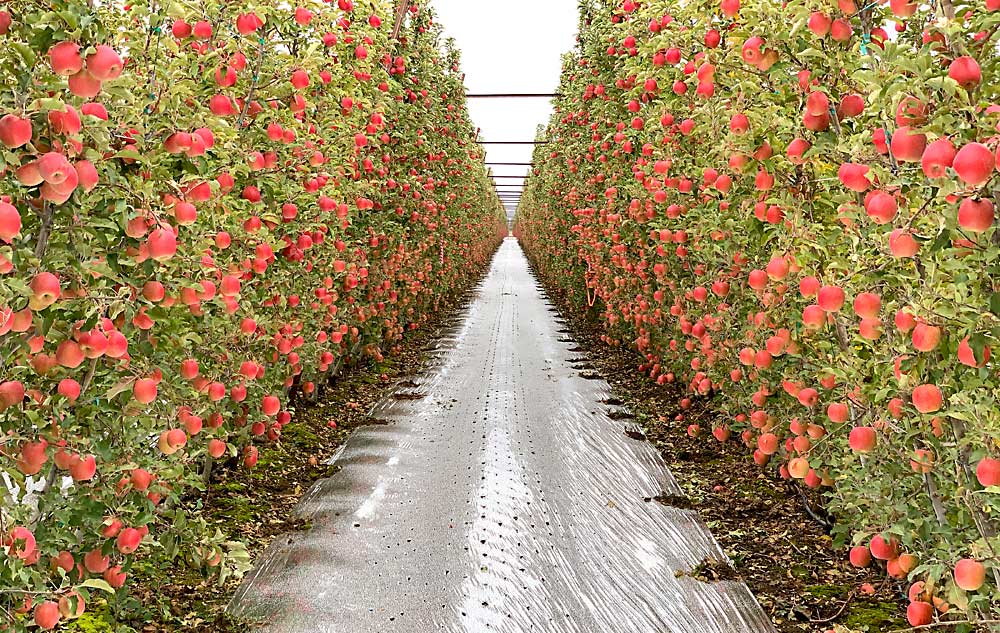
Just as red color attracts consumers to apples on the shelf, seeing all the red, exposed apples in an orchard attracts growers to the technology that delivers color gains.
“It’s pretty hard to look at this photo and say, ‘Yeah, I don’t know,’” said Washington State University’s Karen Lewis, sharing photos of the results of pneumatic defoliation during a talk about the technology at the North Central Washington Apple Day in January.
“This just screams at you and says, ‘This is a block I can get the most efficient use out of whatever inputs I need for harvest, be it people or machines,’” said Lewis, the director of WSU Extension’s Agriculture and Natural Resources Program. If growers were to do this sort of leaf removal by hand — and some do — they are looking at $800 to $1,600 an acre, Lewis said. “This is at 3 mph. You can get through an acre in roughly 30 minutes.”
When Lewis organized the first demonstration of a mechanized leaf blower in Washington in the fall of 2019, she thought growers would be eager to have a tool to get good color on late-harvesting varieties.
Two years after their introduction to the market, she estimates 50 or 60 of the machines, from different manufacturers, were deployed in Washington orchards.
Now, growers are testing them all season long.
“At first, we were just thinking about Fuji and Pink Lady,” Lewis said. “But it wasn’t long after that I heard people doing it in midseason varieties like Honeycrisp and SweeTango.”
Several apple-specific pneumatic defoliators are now available in the U.S. market, including the REDpulse from German manufacturer Fruit Tec, the Olmi, which is manufactured in Italy, and U.S.-made models from Blueline and Gearmore of California, which produces the Collard Leaf Remover.
They all use the same basic approach — pulses of air generated by a rotating drum — but the technology is a little different, Lewis said.
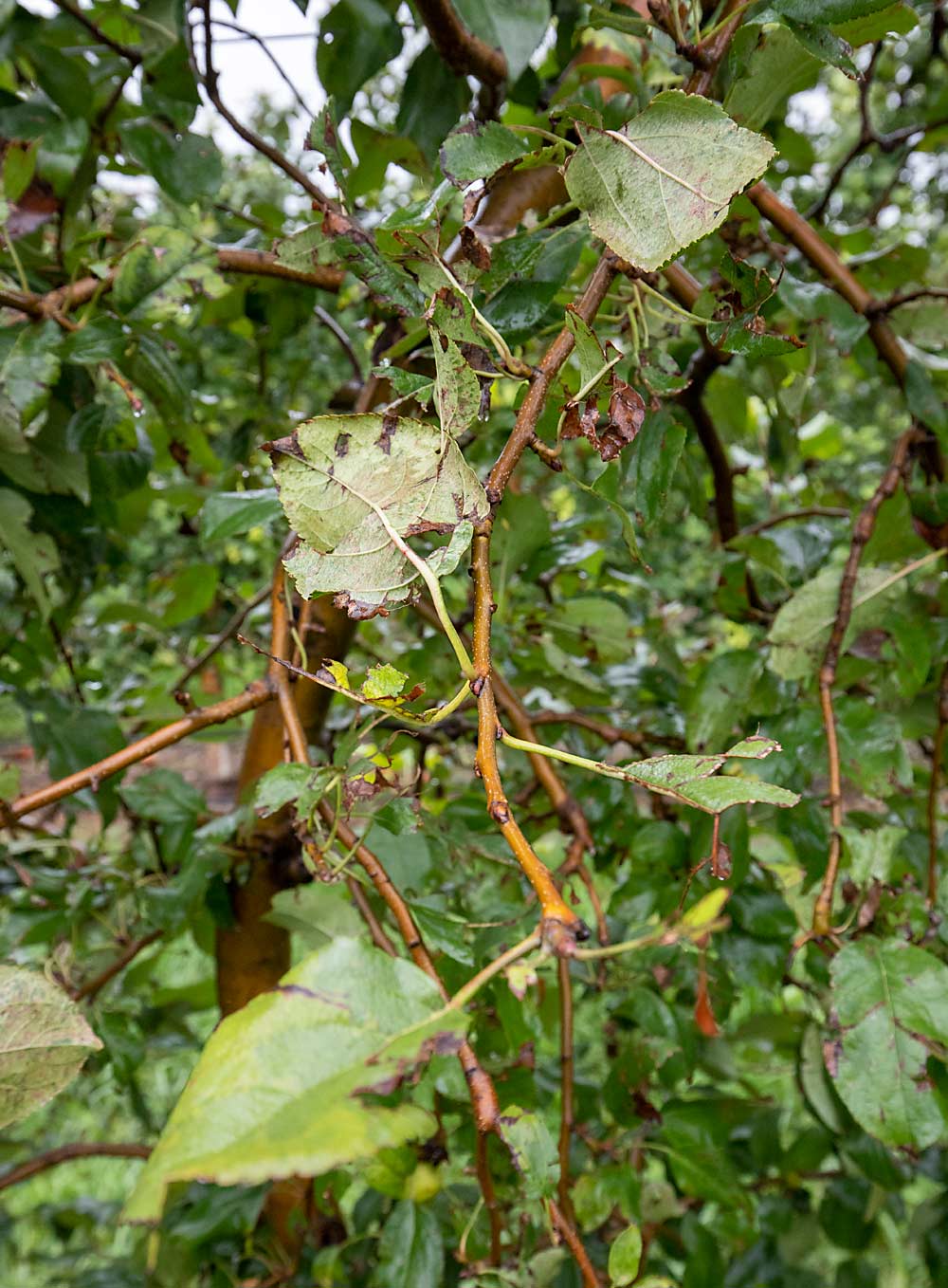
Earlier-season uses raise more questions about the potential risks of sunburn and the loss of leaf capacity to produce carbohydrates. Lewis said she and WSU tree fruit physiologist Lee Kalcsits hope to launch a research project to answer those questions next year.
But in other regions and climates, experience so far shows minimal downsides to season-long use, compared to the fruit-value gains of increasing color.
“We’re starting with Galas and going right through Fujis,” said Jim Schupp, a Penn State University horticulture professor based in Adams County, where growers can sometimes struggle to get apples to color.
“There’s two environmental factors that limit red color formation: temperature and light. We can’t do much about temperature but complain about it, but we can do something about light,” he said. “Even with properly trained dwarf trees, there’s a zone of low light in the lower third of the canopy where we can move the needle.”
Schupp started trials in 2020 with a REDpulse, on loan from Provide Agro, an Ontario-based distributor for Fruit Tec. He’s found that the color gains vary by variety. He measures the fruit surface area covered with red blush and found that Buckeye Gala consistently gained about 15 percent more blush with defoliation in the past two seasons. Honeycrisp, no surprise, had more variable results, with a 10 percent increase in color in 2020 and 22 percent in 2021. Brak Fuji, which is already difficult to color, averaged about a 10 percent gain.
“That 15 percent sounds modest, but you just went from a U.S. No. 1 to Extra Fancy,” he said.
Gaining red color has strong economic benefits, but Schupp said it starts with planting redder strains, changing pruning and training for more light interception, dialing in nutrition and then adding a tool like a defoliator or reflective ground cover. (See “The redder the better.”)
“You can’t go into big, unpruned, semidwarf trees with this and expect a miracle,” he said. “It’s a defoliator, not a miracle.”
Growers need to keep in mind that the pulses of air produced have an effective range of 16 to 18 inches (in the case of REDpulse) from the machine, he said. Orchards don’t need to have a narrow fruiting wall canopy, but they do need to have well-pruned trees so that no stiff branches jut out into the defoliator’s path.
He’s seen the best results by following the manufacturer’s recommendations of 1.5 mph, and he said that by increasing the pace of the tractor too much he saw some reduction in color gains.
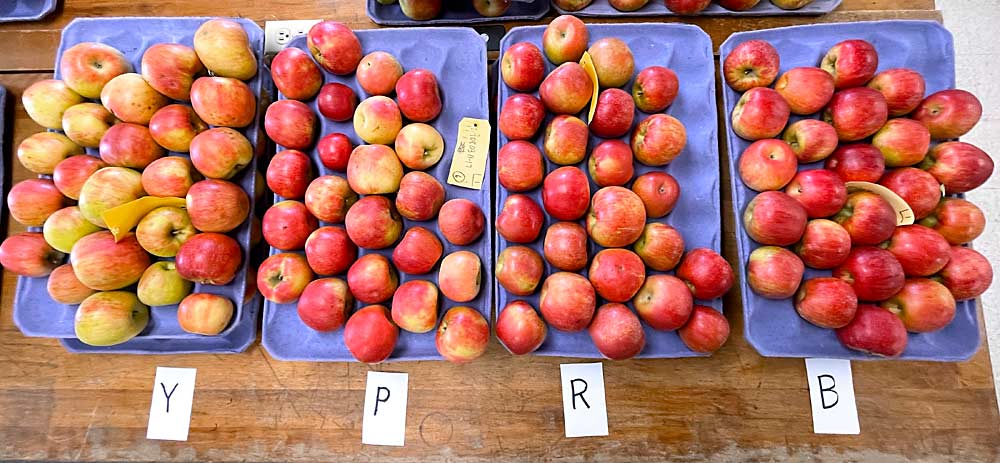
As for the potential downsides of defoliation? Schupp said he’s not worried about return bloom, as the flower buds for next year have already set long before harvest approaches. Losing a lot of leaves, and the carbohydrates they provide, could impact winter hardiness, but Schupp said the approach is unlikely to defoliate enough to make that an issue.
“We’re shredding some and blowing some off entirely, but there is still a lot of leaves and partial leaves left,” he said. “We like to think our apple trees are working maximum capacity all the time, but they actually work bankers’ hours; they shut down in the middle of the day when it’s too hot. So, when you take off foliage, the (remaining) leaves actually increase their function to compensate for the loss.”
The larger risk for using the defoliator on early or midseason varieties in Washington may be sunburn, Lewis said.
That certainly is a concern in Australia, said Nic Finger, who runs a grower support business in Australia, specializing in helping growers make business decisions around technology implementation.
Pink Lady is driving the adoption, but “right now in the Goulburn Valley they are using it before Gala harvest,” Finger said in late January. “Galas are risky because every 10 years or so, they get cooked.”
In her talk, Lewis shared data from a small trial Finger conducted for Plunkett Orchards of Victoria. Using the REDpulse in a Pink Lady block resulted in a 16 percent increase in the fruit packed. It also boosted the amount of premium grade fruit from 56 percent to 73 percent of the yield.
Finger said the Tatura trellis systems common in the region have a narrow canopy that is very conducive to the defoliator; they also pair well with hedging, which is becoming more common as well.
For growers who stand to gain economically from better color and have the scale to justify the machines, it’s a good tool, he said. Smaller growers who can’t justify the purchase sometimes turn to contractors offering defoliation as a service.
The downsides include occasional small punctures and bruising, Finger said. He’s also heard some concern about spreading disease inoculum, such as pseudomonas, but thinks the preharvest timing reduces the likelihood.
If growers already have really high-colored strains, it may be unnecessary, Finger added.
“It’s a business decision at the end of the day, like everything,” he said. “Any edge you can get is probably worth it at the moment.”
—by Kate Prengaman
Creating the conditions for color
This is an excerpt adapted from the article, “Apple Red Skin Coloration: A Grower’s Checklist,” published by Penn State Extension. For more details on color physiology, the role of nutrition, cultivar genetics and fruit maturity, visit: extension.psu.edu/apple-red-skin-coloration-a-grower-s-checklist.
The importance of fruit color can’t be underestimated, as it can increase sales at the marketplace and increase your profits. Not to be forgotten are the nutritional benefits from deeply colored skin, since a darker color indicates the presence of a high concentration of antioxidants. Replace older, less colored orchards with improved red strains when they become available.
Use leaf and soil analysis to maintain moderate tree vigor, with adequate levels of nitrogen and potassium. Use thinning cuts during dormant pruning to create a narrow canopy and reduce shading from excess branching. It is important to get a significant amount of UV radiation from sunlight in the last few weeks of ripening to get the best color. If standard methods are not working well, consider plant growth regulators to reduce vigor or alter the maturity window, or the installation of reflective mulches to maximize the UV radiation that hits. (See “The redder the better.”)
The ideal conditions for red color development in apples correspond to bright, clear days with temperatures of around 77 degrees Fahrenheit (25 Celsius) and cool nights (59 F, 15 C) throughout preharvest (three weeks before harvest). When exposed to these conditions, trees are not stressed during the day, thus increasing their canopy photosynthesis and decreasing respiration rates at night. Increasing photosynthesis promotes the accumulation of sugars (carbohydrates), and decreasing respiration rates helps to decrease the breakdown of sugars. Therefore, under the above temperature conditions, more carbohydrates are readily available.
Anthocyanin biosynthesis is suppressed at warmer temperatures (hot days above 90 F or 32 C and warm nights above 68 F or 20 C), thus making it difficult to produce apples with sufficient red skin coloration in hot seasons, especially early-harvest varieties such as Honeycrisp.
Light intensity and quality (wavelength) are also crucial factors affecting apple red skin coloration during development and ripening. This is particularly important, as all the chain of biochemical reactions involved in the synthesis of anthocyanins are induced by light. Skin color pigments are synthesized as a response to stressors such as sunlight, specifically in the ultraviolet (UV) radiation wavelengths. The more that apples are exposed to the sun’s rays — specifically UV wavelength — the more color that the fruits will develop on the skin. But this is only to a certain limit, as too much UV radiation can cause fruit sunburn, just like in human skin.
Suboptimal temperature and light conditions present in the mid-Atlantic at the time that varieties such as Honeycrisp are harvested in recent years have resulted in a poor or marginal red skin coloration development in these varieties. As environmental conditions are difficult to control, the focus must be placed on managing the tree, its physiology and uniform light distribution for improving coloration.
Pruning is the long-established method of increasing light distribution in the canopy to promote red fruit color and other light-driven processes, such as flowering and fruit set. Conduct annual dormant pruning, making thinning cuts to remove entire limbs at their point of origin. This type of cut slows and limits the amount of regrowth, thus thinning out the branches and creating windows where sunlight can penetrate the canopy. Remove the largest limbs, especially in the top half of the tree, to create a cylindrical or cone-shaped canopy. Then, thin out additional limbs to space them out both radially and vertically. When tree vigor is strong, summer pruning to remove upright shoots and leaves can confer a temporary increase in sunlight. Summer pruning is typically undertaken about two weeks before the start of harvest to provide additional sunlight to promote red coloration.
Root pruning is another technique to reduce canopy vigor and improve red color. Root pruning is done with a tractor-mounted subsoiling blade or coulter wheel-mounted offset on a toolbar. Root pruned trees have shorter shoots and smaller leaves, contributing to increased light penetration. To be effective, root pruning is done early in the season, just prior to or at the start of growth. Both sides of the row are cut at 16–18 inches from the trunk so as to remove enough roots to have an effect.
Jim Schupp is a professor of pomology at Penn State University. Macarena Farcuh is an assistant professor and extension specialist at the University of Maryland.

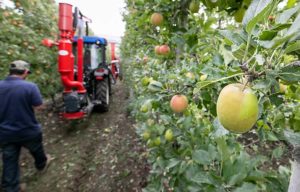
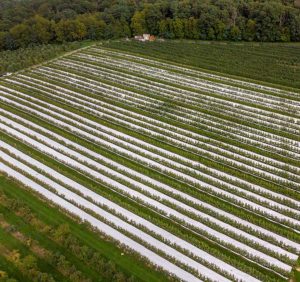





Leave A Comment